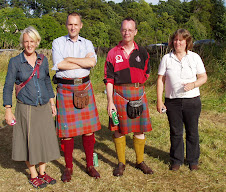Very miscellaneous non-knit
Wren, I
didn’t see you and your boyfriend at the Farmers' Market, alas – but I saw your fractal cauliflower!
And admired it, as I was queuing for some dirty, misshapen vegetables. Unless
they had another one in the van.
I had a
very successful time. We had pork chops for lunch yesterday, very tasty, and
will have mutton today. The woman who sold me the rolled shoulder of, said that
it could be roasted, slowly, but I think I’ll go for braising on a bed of the
aforementioned vegetables.
Nicola
Fletcher, half of the husband-and-wife team who run Scotland ’s
– maybe Britain Glasgow University
My
brother-in-law just sent me a
wonderful link. But what’s this about its being banned?
Do read catdownunder on the
subject of antipodean water and its descent through plugholes.
One thing
is certainly true of the antipodes, though. I once had the pleasure of meeting Margaret Stove
and her husband. He is a countryman, and it was his first trip north of the
equator. He remarked on how very odd it was to find the sun in the southern
sky.
There is a
story in Herodotus somewhere (I think) of some intrepid Greek sailors who reached the Cape of Good
Hope , and came home with the news that they had seen the sun to
their left as they sailed eastwards. The stay-at-home Greeks responded with
pull-the-other-one, but it is the very detail, of course, which proves to us that
they had really done it.
Cat’s
preceding blog entry is about the usefulness of the ancient languages in later
life. I was with Greek Helen when her first son, Oliver, was born. (He died at
six-and-a-half weeks. His birthday was three days ago.) Her husband was
travelling from Cairo to Edinburgh
Helen, in
those days, didn’t know Greek. She’s way beyond me now.
Knitting
The
Brownstone is speeding forward. When one catches sight of it lying about, it
looks a plausible size and shape for a young man, and I am really rather
hopeful for it.
We’re not
concerned with colour here, although in fact it’s come out better than one
might have expected.





Hi Jean, I think the iPad video is "banned" because it is a spoof. They didn't do a very good job of banning though, since this and all of the other videos are readily available on YouTube!
ReplyDeleteThe Brownstone is wonderful. I am still tempted to knit one, but just don't know who I would make it for. Out of 3 sons, a son-in-law and a husband the only potential sweater wearer I have is my husband. And he is 6' 4", which would mean a lot of yarn and a lot of knitting.
ReplyDeleteAnd I was glad to read you might have found a solution for your husband for when he is out and about in Strathardle. It would be so nice for you if, rather than give up your country life completely, you can find ways to make it work for you. That tetrapod looks like just the thing.
I have yet to travel to the southern hemisphere, but now I can look forward to one more novelty when I get there - the sun appearing in the northern sky. Though I knew that new constellations would come into view, I had never thought about the change in the sun's apparent position. After a lifetime of watching the sun head south for winter, how odd it will seem to be on the "other side" of it!
ReplyDelete-- Gretchen
The sun crosses over to the other side every year, at the equinoxes, but we usually don't notice because it doesn't go very far past the midline. At the equinoxes, the sun is directly overhead. I don't quite understand how it can be directly overhead for the entire planet, but that's what they tell me.
ReplyDeleteCould you tell us more about the framed calligraphy in the background of the Brownstone photo?
ReplyDeleteIt looks very interesting.
Thanks for sharing the photos of your knitting in progress.
Dear Tamar, Sun not directly overhead for the whole planet - not ever.
ReplyDeleteEquinoxes are when it is directly overhead at the equator, so that day and night are equal for the whole planet. Solstices are when it moves to being directly overhead on the tropic lines - north or south, giving us midsummer and midwinter, with the unequal day/night ratios, depending on whether it is our turn to have it.
Hope this hasn't confused the issue even more!